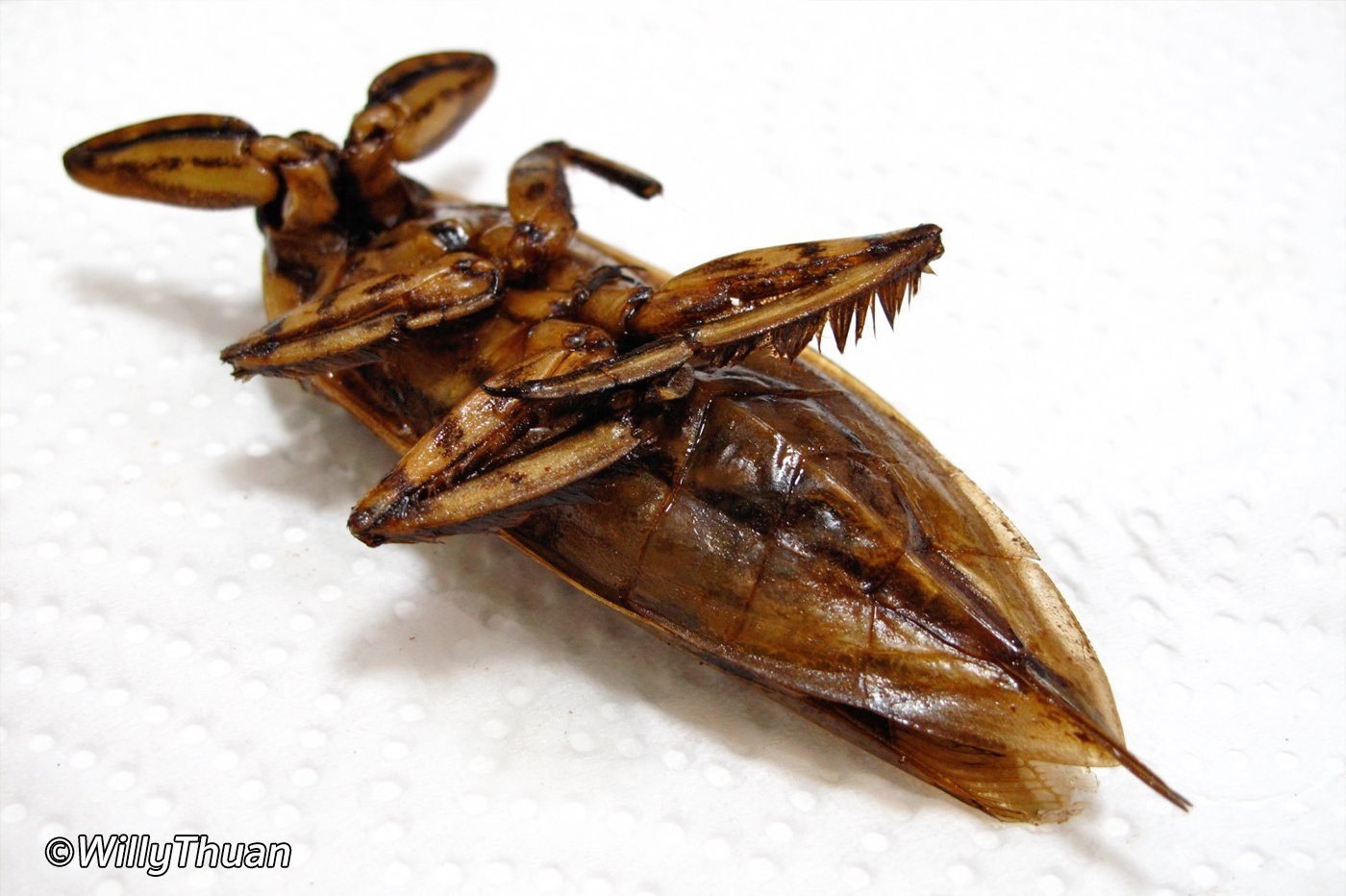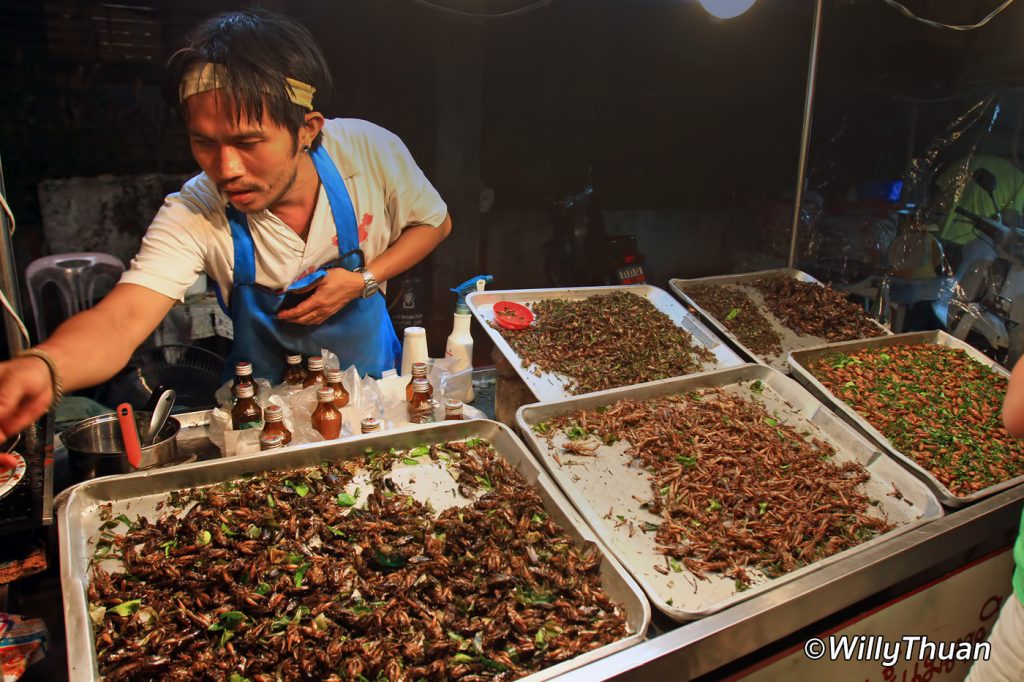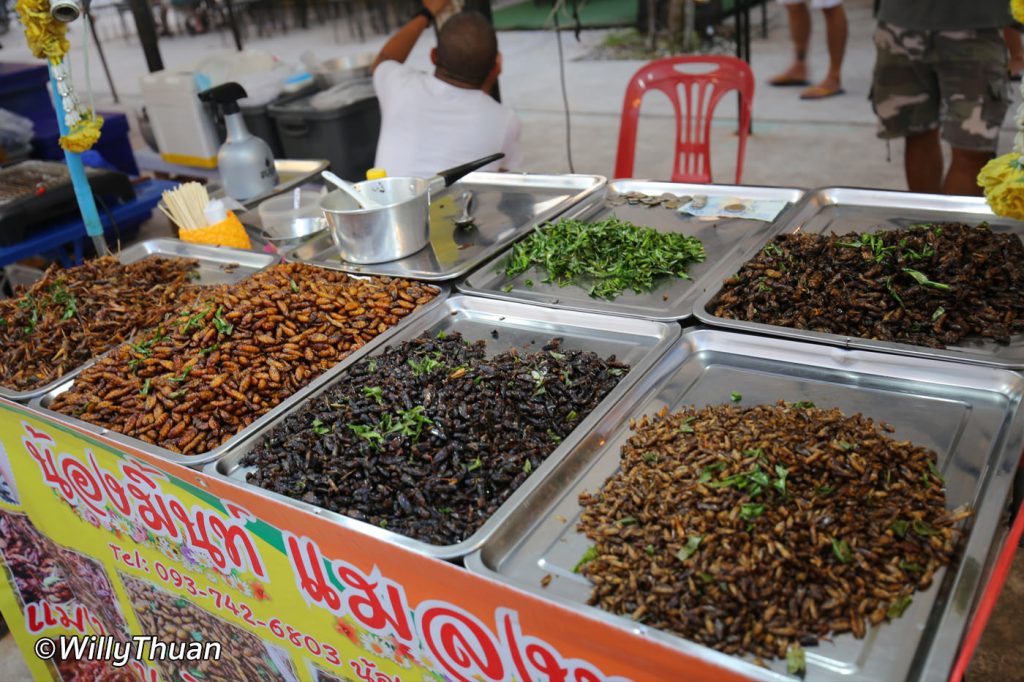Where to find fried insects in Phuket
Eating Fried Insects in Phuket and Thailand seems to be the ‘ultimate cultural challenge’, so try to answer the following questions:
- How many of you had a bite at one of these appetising bugs sold on carts in the streets of Thailand? A few, I suppose.
- How many of you LIKED IT? less!
- How many of you actually ENJOYED eating bugs? 😀
The Story Behind Thailand’s Bug-Eating Culture
Before we dive into our taste test adventures, let’s understand why people started eating insects in the first place. This tradition didn’t begin as a tourist attraction; it started out of necessity. In northeastern Thailand, particularly in the Isan region, people have been eating insects for centuries as an affordable protein source when meat was scarce or expensive.
What began as economic survival became cultural tradition. Today, Thailand is the world’s largest producer of edible insects, with over 20,000 registered farming enterprises. While many Thais outside northeastern regions view insects with scepticism, in Isan provinces, people consume bugs like we eat potato chips: at breakfast, lunch, and dinner. The practice makes sense: insects are incredibly efficient protein producers. The practice makes perfect sense when you consider the nutritional benefits. Insects are 12-25 times more efficient at producing protein than conventional livestock. They’re packed with high-quality protein, vitamins, minerals, and healthy unsaturated fatty acids.
Eating insects is all about culture and education. If you look at them objectively, many just look like brown shrimps, but our conditioning says: Shrimp = good, grasshopper = bad! But it’s not like this everywhere. Often related to economic hard times in history, people ate them first by necessity, then taboos started to fade, and it became about taste, fun, or even fashion.
To be honest with you, we don’t really like them all, but we tried them all! We hope you appreciate the sacrifice we made last night to write this story. We went to a place in Phuket where we knew insects were always available, bought 20 baht of each, and drove back home. We wrote our will, kissed our families goodbye, just in case, and displayed the feast in front of us. Then we picked the smallest one… surprise! It’s almost as bad as we thought it would be! Well, not all of them, so let’s dive into the details below.
1. Giant Water Bugs (Mang Da Na)
The biggest, weirdest, scariest, with the strongest taste of all fried insects found in Phuket. These massive aquatic insects are actually considered a delicacy in Thai cuisine. The giant water bug’s essence is so prized that it’s used to make nam prik mang da, a traditional chilli paste that’s served in upscale Thai restaurants.
The giant water bug is actually harvested from rice paddies and waterways throughout Thailand. Local farmers often catch them at night using lights, as the bugs are attracted to bright illumination. What makes them unique is their incredibly potent flavour; just a small amount can season an entire dish.
Female: Eat only the inside, which contains a creamy, pungent liquid that tastes strongly of blue cheese mixed with bubble gum.
Male: Usually chopped and added to salads for flavour. (Read more)
☆ Size: XXL
☆ Consistency: Meaty like chicken with a creamy centre (yuk :D)
☆ Taste: Like bubble gum with a very strong, almost medicinal aftertaste!
✎ Which drink: Tequila shots… make it 2!
2. Silk Worm or Pupa (Nhon Mhai)
Silkworms are big, fat, and shiny, fried with kaffir leaves – this is a popular snack throughout Thailand. These pupae are actually a byproduct of Thailand’s silk industry. After the silk is harvested, the pupae don’t go to waste. Silkworm pupae are incredibly nutritious, containing about 23% protein and rich in essential amino acids. In some parts of Thailand, they’re even processed into pasta for those who want the nutrition without the visual reminder of what they’re eating. The creamy inside contains concentrated protein and healthy fats, which explains both the nutritional value and the distinctive taste.
☆ Size: XL
☆ Consistency: Soft outside, creamy inside (and yes, that’s as disturbing as it sounds).
☆ Taste: Strong and nutty with a bitter aftertaste that lingers.
✎ Which drink?: Gewürztraminer (or beer)
3. Grasshoppers (Takaten)
Always popular because of their friendly, recognisable shape that makes them look like shrimp; they’re actually the easiest to try since they look ‘dry’. Grasshoppers are among the most commonly consumed insects in Thailand. What we found interesting is that grasshoppers are often imported from neighbouring countries to meet Thailand’s demand. They’re typically seasoned with garlic, salt, and sometimes chilli powder before frying. The crunchiness comes from their exoskeleton, while the inside provides a more tender texture. Many people say they taste similar to roasted peanuts with a slight earthiness.
☆ Size: XL
☆ Consistency: Very crispy with a satisfying crunch.
☆ Taste: Medium to strong taste with a bitter aftertaste like old green tea.
✎ Which drink?: Riesling or Beer
4. Crickets (Jing Reed)
Looks familiar to everyone. Since they’re a bit plump, you can expect them to have some fatty content inside. House crickets are probably Thailand’s most successfully farmed insect. Cricket farming was introduced to Thai farmers more than 15 years ago and has become a significant source of income for rural households. We learned that cricket flour has even been used to make bread, pasta, and protein shakes. The soap-like taste comes from compounds in their exoskeleton, but the nutty flavour develops as you chew.
☆ Size: M
☆ Consistency: A bit crunchy and soft inside.
☆ Taste: Medium at first, then a bit bitter… like soap with nutty undertones.
✎ Which drink?: Sauvignon Blanc… or Beer
5. Jing Reed Khai (Mini Crickets)
Almost the same as regular crickets, but less scary to bite since the inside won’t pop in your mouth. Beginners often prefer these smaller crickets. The smaller size means less of that creamy interior that puts many people off. They’re often fried with aromatic herbs, which masks much of the insect flavour and makes them taste more like seasoned snacks.
☆ Size: S
☆ Consistency: Slightly crunchy, then soft inside.
☆ Taste: Very light, mostly kaffir leaf taste and oil.
✎ Which drink?: Chardonnay or Beer!
6. Red Ants (Mod Daeng)
Maybe the easiest to eat because their tiny size isn’t intimidating. These are harvested from nests in trees and are considered quite the delicacy. Red ants have a naturally sour taste due to formic acid in their bodies. This sourness actually complements spicy Thai dishes perfectly, which is why they’re often used in traditional Isan cuisine. The Slow Food Foundation even recognises Thai red ants as a heritage food product.
☆ Size: XS
☆ Consistency: Soft and slightly chewy if you take a lot at once (just as you would expect when shovelling a spoonful of red ants in your mouth!)
☆ Taste: Salty and oily with a slight tanginess.
✎ Which drink? Côtes du Rhône.
7. Bamboo Worms (Rod Duan)
Probably the most popular insect snack among Thais; they can easily be found everywhere. These caterpillars live inside bamboo shoots and are harvested when the bamboo is cut. Bamboo worms are incredibly nutritious, containing about 65% protein by dry weight. They’re also rich in essential amino acids and minerals. The cheesy taste comes from the bamboo they’ve been eating their whole lives, which gives them a slightly sweet, nutty flavour. Many people compare them to corn nuts or cheese puffs.
☆ Size: S
☆ Consistency: Just a bit crusty outside, then soft inside.
☆ Taste: Salty at first, then comes a cheesy aftertaste.
✎ Which drink?: Sauternes or Beer!
8. Red Ant’s Eggs (Kai Mod Daeng)
Red ant eggs come as a salad and look like white rice grains, much bigger than the ants we’re familiar with. This is considered one of the most prized ingredients in northeastern Thai cuisine. Red ant eggs are only available seasonally from February to May. They’re incredibly difficult to harvest; collectors have to climb tall trees and brave angry ants to get them. The eggs are often mixed into spicy salads (larb) or papaya salad (som tam). Their natural acidity pairs perfectly with the sour and spicy flavours typical of Isan cuisine.
It can be found at Tung Tong Restaurant in Kathu.
☆ Size: XS
☆ Consistency: Very soft, as they’re usually served as a salad.
☆ Taste: Sour but good, with a fresh, citrusy note.
✎ Which drink?: Sauvignon Blanc (or Beer?)
9. Horseshoe Crab (Mang Da Talay)
You might say it’s not an insect, but in Thai, it means ‘Sea Insect’. And it’s weird enough to be listed here. We eat only the eggs as a salad, and that creature’s blood is BLUE! These ancient creatures are more closely related to spiders than crabs! The blue blood comes from copper-based hemocyanin instead of iron-based haemoglobin, like humans have. Horseshoe crab eggs are considered a luxury item and are often compared to caviar, though they’re much saltier and have a distinct ocean taste. (Read more…)
☆ Size: XXXXXL
☆ Consistency: Eggs are quite hard and a bit rubbery
☆ Taste: Fishy with a briny ocean flavour.
✎ Which drink? Pouilly-Fumé
10. Sea Crickets (Chakachan Talay)
Chakachan Talay is a speciality from north Phuket and can be enjoyed in restaurants around Mai Khao Beach and Sai Kaew Beach. They’re very good deep-fried, but aren’t easy to find. These marine arthropods are actually quite close to regular shrimp in terms of taste and texture. The main difference is a slightly more intense brininess and a firmer crunch. They’re often served with lime and chilli sauce. One good place is Thanoon Seafood.
☆ Size: M
☆ Consistency: Very crispy, like a dry shrimp
☆ Taste: Light and salty, and similar to shrimp with a subtle difference.
✎ Which drink?: Riesling or beeeeeer…. lots of it
Where to Find Fried Insects in Phuket?
Most of them can be found at those occasional village fun fairs for the modest sum of 20 Baht per small bag, each of which contains more than you need.
















